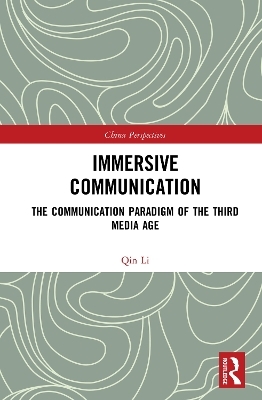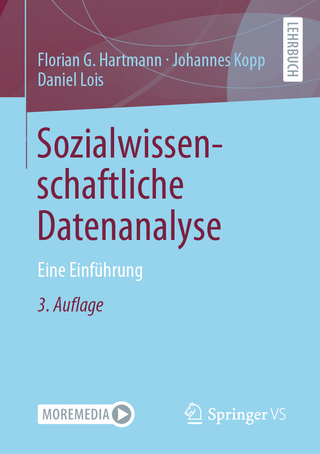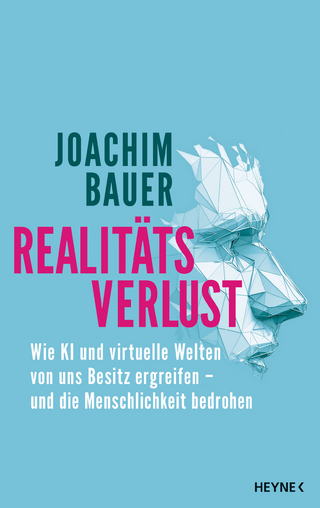
Immersive Communication
Routledge (Verlag)
978-0-367-37671-0 (ISBN)
Communication, like the atmosphere itself, is ubiquitous and essential for humans and with the development of new technologies, such as wireless internet, 3D printing and virtual reality, it has become almost impossible to live without it. In addition, means of communication have changed immeasurably.
This book proposes a new research paradigm that incorporates new features and factors of communication and a new theoretical framework named “immersive communication”. Pointing out that communication today has moved beyond the bi-directional, mass communication of "the second media age" to ubiquitous, immersive communication in "the third media age", the author discusses the definition, characteristics, information structure, and models of immersive communication using various examples including Fitbit, Apple, 4G and other technologies, while envisioning future applications of the immersive communication model.
Scholars and students of communication studies, especially those interested in the manifestations of the new media age, will all benefit from this book. It will also appeal to readers interested in new media and communication theories.
Qin Li is the Director of National Communication Strategy Research Center, an associate professor at Renmin University of China’s School of Journalism and Communication, and a Research Fellow at the China Journalism and Social Development Research Center. Her famous publications include Immersive Communication: Communication Paradigm of the Third Media Age (2013), Bing Media: the theory and practice of immersive communication (2019).
I:Introduction. 1.1 Literature Review: Theories on Media Evolution - From Interpersonal Communication to Immersive Communication. 1.1.1 The First Media Age and The Second Media Age. 1.1.2 Evolutionary trends of mediamorphosis: "Coevolution and Coexistence" and "Anthropotropicness" . 1.1.3 Media space, environment, and ecological theory define the relationship between media, human and environment. 1.1.4 How ways and modes of communication evolve to "vanishing boundaries," and how communication tools and communication relations are reconstructed. 1.2 The origin and theoretical evolution of the concept of "immersion" . 1.2.1 The concept of "immersion". 1.2.2 Immersion’s Application in Virtual Reality. 1.2.3 Remote Presence and Immersive Communication. 1.3 Media Technology and Social Development: Conditions and Environment for the Evolution of Immersive Communication. 1.3.1 From "informational" survival to "post-information" survival. 1.3.2 From "localized" survival to "ubiquitous" survival. 1.4 Limitations of existing theories and the research significance. 1.4.1 Media morphosis breaks through traditional spatial categories. 1.4.2 The concept of "presence" has undergone a qualitative change. 1.5 Summary. II: The Definition of Immersive Communication. 2.1 Logic of the New Definition. 2.1.1 "Technological determinism" "decides" immersive communication as a new mode of communication. 2.1.2 The "Anthropotropic" trend leads people to choose the most suitable things in order to survive. 2.2 Definition of Immersive Communication. 2.3 The Breakthroughs of the New Definition Compared with Existing Definitions of Communication. 2.3.1 Immersive communication reconstructs the three "spaces." 2.3.2 Immersive communication reconstructs the relationship between media and the human being. It’s the hottest and coolest medium. 2.4 Summary. III: Morphological Characteristics of Immersive Communication. 3.1 Immersive Communication Is Human-Centered: Everything Is Media, and Humans Are also a Media Form. 3.2 Immersive Communication Is Instant and Anytime: The Present, Past, and Future Are Integrated, and the Virtual World and Physical World Coexist Integrated, Instantaneous, and Long-Lasting. 3.3 Immersive Communication Is Pervasive Anywhere and Everywhere: "Remote" Presence and "Ubiquitous" Presence Converge the Fixed, Mobile, and Virtual Coexistence. 3.4 Immersive Communication Is All-Powerful: Boundaries Between Entertainment, Work, and Life Vanish; Cloud Computing Integrates Everything. 3.5 Summary. IV: The information content and movement mode of immersive communication. 4.1 Language Form. 4.1.1 Previous media languages. 4.1.2 The pan-media language of the whole environment: the monitoring camera and environmental advertisements in Intelligent City. 4.1.3 Humans as the source of media language and information content. 4.1.4 The language of the virtual world. 4.2 The linguistic hegemony of immersive media. 4.2.1 Presenting ideas in immersive communication: Moistens everything softly and silently. 4.2.2 Media advertisement and the social discourse power of immersive communication. 4.3 Information presentation. 4.4 The paths and characteristics of information movement in immersive communication. 4.5 Summary. V: The model of immersive communication and its graphic forms. 5.1 The main communication models in communication studies. 5.2 The model of immersive communication. 5.2.1 The communication process: comprehensive connectivity based on modern information technology. 5.2.2 Communication relations: human-centered communication structure. 5.2.3 Communication goals and effects: The Communication Immersive Index. 5.3 The model of immersive communication function: IC matrix. 5.3.1 The IC matrix: basic features. 5.3.2 The meaning of the 25 intersections in the IC matrix. 5.3.3 The theoretical breakthrough and research contribution of the IC matrix. 5.4 The model of immersive communication process: the IC stereo helix. 5.4.1 The explanation of the IC stereo helix. 5.4.2 The significance of the IC stereo helix. 5.5 The model of immersive communication relationship: the IC schematic. 5.5.1 The explanation of the IC schematic. 5.5.2 The meaning of the IC schematic. 5.6 Summary. VI: The Application and Verification of the Immersive Communication Model. 6.1 The Application of the Immersive Communication Models. 6.1.1 The general application of the immersive communication model. 6.1.2 Dividing the Three Media Ages with the Immersive Communication Model. 6.2 Case Verification of the Immersive Communication Model. 6.2.1 The First Media Age: Lobby Leaflets & Unidirectional Transmission. 6.2.2 The Second Media Age: Elevator Television & Focus Awareness. 6.2.3 The Third Media Age: Panoramic Monitoring & Personalized Service. 6.3 Summary. VII: How Immersive Communication Guides the Formation of the "Third Media Age". 7.1 The Inevitable Cause of the Formation of the "Third Media Age". 7.1.1 The revolution of media ontology and changes in social productivity. 7.1.2 Changes in the Media Space and the Transformation of Human Living Space. 7.1.3 Changes in the Social Functions of Media Bring Changes to Social Relations. 7.2 The Concept and Characteristics of the "Third Media Age". 7.2.1 The concept of the "third media age" . 7.2.2 The Characteristics of the "Third Media Age". VIII: "Immersive Communicators" and Their Production & Lifestyle Characteristics. 8.1 Information Acquisition by Immersive Communicators. 8.2 The Lifestyle of Immersive Communicators. 8.3 The Production Mode of Immersive Communicators. 8.4 The Entertainment of Immersive Communicators. 8.5 The Future of Immersive Communicators: the Commencement of Biological Media. 8.6 Summary. IX: Conclusion: Immersive Communication Opens a New Chapter in Human Communication. 9.1 Revolutions in Human-Media Relations. 9.2 Revolution of Communication Content. 9.3 Revolution of Communication Methods. 9.4 Revolution of Media Function.
| Erscheinungsdatum | 10.12.2019 |
|---|---|
| Reihe/Serie | China Perspectives |
| Zusatzinfo | 1 Tables, black and white; 14 Line drawings, black and white; 12 Halftones, black and white |
| Verlagsort | London |
| Sprache | englisch |
| Maße | 156 x 234 mm |
| Gewicht | 426 g |
| Themenwelt | Kunst / Musik / Theater |
| Geisteswissenschaften ► Geschichte | |
| Sozialwissenschaften ► Kommunikation / Medien ► Medienwissenschaft | |
| ISBN-10 | 0-367-37671-7 / 0367376717 |
| ISBN-13 | 978-0-367-37671-0 / 9780367376710 |
| Zustand | Neuware |
| Haben Sie eine Frage zum Produkt? |
aus dem Bereich


